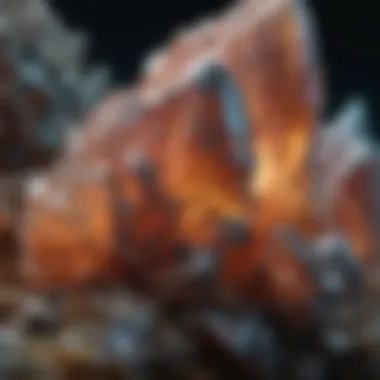Exploring the Distinction Between Rocks and Minerals: A Comprehensive Guide for Enthusiasts


Rock and Fossil Identification
Rocks and minerals hold a significant allure for rock and fossil enthusiasts, each boasting unique characteristics that differentiate them in the geological realm. Understanding the distinctions between rocks 🪨 and minerals 💎 is pivotal in this captivating field. By delving into their composition, appearance, and formation, collectors can gain valuable insights into the world beneath our feet. Let's explore the various types of rocks and fossils, key characteristics to look for, and essential tools for accurate identification. As enthusiasts embark on their journey to differentiate between these geological entities, a keen eye for detail and a passion for earth sciences are crucial companions.
Collecting Tips and Techniques
When diving into the world of rock and fossil collection, adhering to best practices is paramount. From selecting prime collecting sites to safely extracting specimens, enthusiasts must navigate each step with care and precision. Discovering the art of identifying optimal locations for collection and mastering the extraction process are skills that elevate a collector's expertise. Moreover, understanding how to safely handle and transport delicate specimens ensures their preservation for future generations to appreciate.
Preservation and Display
As collectors amass an array of rocks and fossils, preserving these treasures becomes imperative. Techniques such as cleaning, stabilizing, and storing specimens play a crucial role in prolonging their lifespan. Adopting proper preservation methods safeguards the integrity of each piece, allowing their beauty to endure the test of time. Furthermore, exploring creative display ideas enables enthusiasts to showcase their collections in engaging and visually captivating ways, bringing the wonders of geology to life.
Geological Insights
Embark on a journey through geological formations and processes, tracing the historical significance of rocks and fossils in shaping the earth's narrative. From understanding the forces that sculpted landscapes to unraveling the stories embedded within each specimen, enthusiasts unravel a tapestry of natural history. Delve into notable discoveries that have transformed our understanding of the planet's evolution, igniting a sense of wonder and curiosity among collectors and scholars alike. Geological insights not only deepen our appreciation for rocks and fossils but also unveil the mysteries that lie beneath the surface of our world.
Introduction to Rocks and Minerals
In the realm of geology, understanding the fundamental disparities between rocks and minerals is paramount. This article serves as a definitive guide for enthusiasts of rocks and fossils, offering an intricate analysis of the distinguishing features that differentiate these geological entities. By delving deep into the composition, characteristics, and geological significance of rocks and minerals, readers will gain a profound insight into their unique traits.
Understanding Geological Entities
The Basic Building Blocks of the Earth
Exploring 'The Basic Building Blocks of the Earth' unveils the foundational elements that shape our planet. The intricate interplay of minerals, rocks, and other geological components forms the core essence of Earth's structure. Understanding these building blocks is crucial as they provide valuable insights into the geological processes that have shaped our planet over millions of years.
Their Role in Earth's History


Delving into 'Their Role in Earth's History' unveils the crucial contributions of rocks and minerals to Earth's narrative. From laying down the layers of sedimentary rocks to the intense pressure that transforms rocks into metamorphic forms, each chapter in Earth's history is intricately woven with the influence of these geological entities. Acknowledging their role offers a profound understanding of Earth's dynamic evolution over time.
Defining Rocks and Minerals
Composition and Structure
Examining the 'Composition and Structure' of rocks and minerals provides a comprehensive view of their intricate makeup. Rocks, composed of various minerals in distinct arrangements, possess unique physical and chemical properties that define their characteristics. The study of composition and structure not only unravels the geological history locked within rocks but also sheds light on the processes that govern their formation and classification.
Physical Properties
Unpacking the 'Physical Properties' of rocks and minerals reveals a wealth of information about their unique nature. Properties like color, luster, hardness, and cleavage play a pivotal role in distinguishing one mineral from another and aid geologists in identifying and categorizing these geological specimens. Understanding these physical properties not only enhances the classification of rocks and minerals but also provides vital clues about their formation and geological significance.
Characteristics of Rocks
Rocks are the foundational elements of the Earth's crust, holding invaluable clues to our planet's geological history. In this article
Characteristics of Minerals
In this elaborate guide on distinguishing between rocks and minerals, the section on Characteristics of Minerals serves as a cornerstone for understanding the nuanced differences between these geological entities. Delving into the unique traits that define minerals, this section sheds light on critical aspects that set them apart from rocks. By exploring the composition, structure, and properties of minerals, enthusiasts gain a deeper insight into the fascinating world of geology.
Unique Traits of Minerals
Chemical Composition:
Within the realm of minerals, the aspect of Chemical Composition plays a pivotal role in delineating one mineral from another. The unique combination of elements that make up each mineral dictates its physical and chemical properties, essential for identification and classification. By understanding the Chemical Composition of minerals, enthusiasts can decipher a mineral's origins, formation processes, and relationships with other minerals. Not only does Chemical Composition offer valuable insights into mineralogy, but it also uncovers the intricate mechanisms that shape our planet's geological landscape.
Crystalline Structure:
Another fundamental aspect of minerals is their Crystalline Structure, a defining feature that sets them apart from rocks. The arrangement of atoms and molecules in a mineral's crystal lattice determines its symmetry, cleavage, and optical properties, unveiling a world of geometric precision and beauty. Exploring the Crystalline Structure of minerals provides enthusiasts with a deeper appreciation for the symmetry and orderliness found in the mineral kingdom. By examining the interplay between atoms within a crystal lattice, one gains a profound understanding of how minerals form and interact under varying geological conditions.


Properties and Varieties
Hardness Scale:
The Hardness Scale of minerals, as pioneered by Friedrich Mohs, serves as a crucial tool for rock and fossil enthusiasts in identifying and differentiating minerals. By assessing a mineral's resistance to scratching and abrasion, enthusiasts can categorize minerals based on their relative hardness, offering valuable insights into their physical properties and formation processes. Understanding the nuances of the Hardness Scale equips collectors with the knowledge needed to assess mineral durability, durability, and geological significance effectively.
Common Mineral Groups:
Exploring the Common Mineral Groups provides enthusiasts with a comprehensive overview of the diverse array of minerals found in nature. By categorizing minerals into groups based on their chemical compositions and structural similarities, collectors can streamline the identification process and deepen their understanding of mineral classification. From silicates to sulfides, each group offers unique insights into the geological processes that give rise to these minerals, enriching collectors' knowledge and appreciation for the Earth's mineralogical diversity.
Distinguishing Factors
Exploring the importance of distinguishing factors is fundamental in understanding the intricate world of rocks and minerals. By discerning the unique characteristics of each geological entity, enthusiasts can gain a deeper appreciation for their composition and significance. In this comprehensive guide, a detailed analysis of distinguishing factors will shed light on the visual, formational, and scientific aspects that differentiate rocks from minerals.
Recognizing Differences
Visual Characteristics
Visual characteristics play a pivotal role in differentiating rocks from minerals. The distinct appearance, color, texture, and luster of each specimen offer valuable insights into their composition and origins. Understanding these visual cues can aid enthusiasts in identifying and categorizing geological entities accurately. Visual characteristics not only enhance the aesthetic appeal of rock and mineral collections but also serve as key indicators of their geological significance.
Formation Processes
The formation processes of rocks and minerals provide crucial clues about their history and evolution. By examining the various ways in which these entities are created, enthusiasts can unravel the environmental conditions and forces that shaped them over time. Whether through volcanic activity, sedimentation, or metamorphism, each formation process imparts unique attributes to rocks and minerals, contributing to their diversity and complexity.
Scientific Significance
The scientific significance of distinguishing between rocks and minerals cannot be overstated. From conducting geological surveys to studying the Earth's crust, accurate identification and classification are essential for research and exploration. By understanding the scientific implications of differentiating rocks from minerals, enthusiasts can contribute to advancements in geology and paleontology, enriching our knowledge of the Earth's geological history.
Practical Applications


Identification Techniques
Mastering identification techniques is essential for rock and fossil enthusiasts seeking to distinguish between various geological entities. Methods such as mineral hardness tests, streak tests, and visual inspections allow collectors to pinpoint the unique properties of each specimen. By honing their identification skills, enthusiasts can build comprehensive collections and enhance their understanding of the geological world.
Collecting and Preserving Practices
Effective collecting and preserving practices are vital for maintaining the integrity and longevity of rock and mineral collections. Enthusiasts must carefully document the location, date, and geological context of each specimen to preserve their scientific value. Proper storage methods, such as utilizing archival containers and protective padding, can safeguard delicate specimens from damage and deterioration, ensuring that collections remain pristine for future study and enjoyment.
Conclusion
Throughout this comprehensive guide, we have elucidated the crucial factors essential for recognizing rocks and minerals accurately. By unraveling the visual characteristics, formation processes, and scientific importance of these geological entities, readers are empowered to discern between them with precision and insight. Moreover, the practical applications discussed provide valuable insights into identification techniques and collecting practices, enriching collectors' experiences and adding depth to their geological pursuits.
The Conclusion encapsulates the core essence of our exploration, emphasizing the indispensable nature of distinguishing between rocks and minerals for enthusiasts. By enhancing their understanding of geological diversity and collection insights, readers are poised to elevate their knowledge and appreciation of the geological world, fostering a deeper connection with the earth's ancient history and processes.
Key Takeaways
Appreciating Geological Diversity
Digging deeper into the realm of geology, Appreciating Geological Diversity emerges as a pivotal aspect that enriches our understanding and reverence for the earth's formations. This section not only celebrates the vast array of rocks and minerals adorning our planet but also sheds light on their unique characteristics and historical significance.
One of the standout features of Appreciating Geological Diversity lies in its ability to showcase the sheer magnitude of geological variations present worldwide. By highlighting the diverse colors, textures, and formations of rocks and minerals, this segment prompts enthusiasts to marvel at the intricate tapestry of the earth's geological heritage, fostering a profound appreciation for its natural artistry.
Furthermore, the inclusion of Appreciating Geological Diversity in this article serves as a beneficial choice for readers by broadening their perspective and expanding their knowledge of geological formations. By immersing themselves in the kaleidoscope of geological wonders, enthusiasts gain a deeper insight into the earth's history and evolution, paving the way for a more profound connection with the planet's geological narratives.
In essence, the unique feature of Appreciating Geological Diversity lies in its ability to provide a holistic view of the earth's geological splendor, offering a sensory delight and intellectual stimulation that captivates while educating enthusiasts. Its unparalleled beauty and scientific significance make it an indispensable component of this article, enriching readers' understanding and appreciation of the diverse geological landscape.
Enhancing Collection Insights
Turning our attention to Enhancing Collection Insights, we uncover a crucial facet that elevates the collecting experience for rock and fossil enthusiasts. This segment goes beyond mere accumulation, delving into the intricacies of building meaningful collections and deriving insights that extend beyond surface value.
The key characteristic of Enhancing Collection Insights lies in its ability to transform collecting from a hobby into a sophisticated pursuit of knowledge and history. By encouraging enthusiasts to not only amass specimens but also understand their origins, compositions, and geological significance, this section enriches their collecting journey with depth and intellectual gratification.
Additionally, Enhancing Collection Insights stands out as a popular choice for this article due to its practical implications for readers. By offering guidance on preserving specimens, cataloging collections, and gaining a deeper understanding of geological processes through collected items, this segment equips enthusiasts with the tools needed to curate meaningful and insightful collections.
The unique feature of Enhancing Collection Insights lies in its ability to inspire a deeper level of engagement with collected materials, fostering a richer connection with the geological world explored in this article. By enhancing enthusiasts' ability to interpret, analyze, and appreciate their collections, this segment empowers them to derive valuable insights and knowledge that transcend the physical specimens, enhancing their overall collecting experience.







